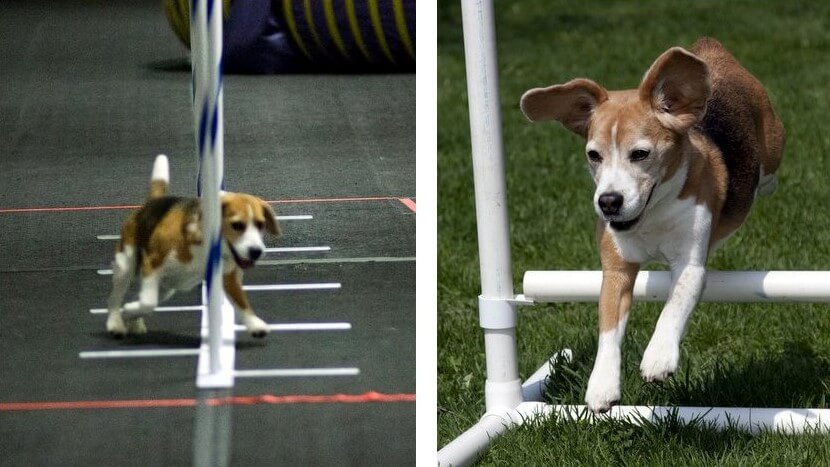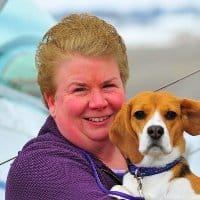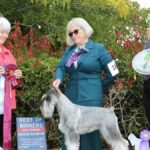This article was originally published in Showsight Magazine, March 2014 issue.
A Life With Beagles
While I was writing this article, a dear friend of mine called to tell me she had just been diagnosed with cancer. Her attitude is great, she likes her doctors and is being proactive about her treatment plan and I hope to celebrate many holidays and achievements with her for a long time. I met her because of my Beagles.
My Beagles have introduced me to some of the best people on earth. Beagle people are much like their dogs: happy, sociable, and we like to hang out together—and eat! A Beagle’s sweet face, sense of humor and wagging tail are beacons to dog lovers. I try to participate in “Meet the Breeds” at shows and events and it was at one of these that I met my friend. She was planning ahead for a puppy; I was planning to breed. Unfortunately my girl only had one puppy who still lives here, but I connected my friend up with another breeder friend and soon a Beagle puppy joined their family. I am so happy right now that she has that Beagle girl as part of her comfort and care team. They give us their unconditional love, and have a great ability to console us while we stroke their soft, velvety ears. What more can you ask of a dog?
A Beagle first entered my life over 25 years ago. I brought home a poorly bred puppy who was still too young to leave her litter; and even at 6½ weeks old, she was smarter than I was. Oh, did I struggle with her; she lived up to all the bad things I’d heard about Beagles: stubborn, loud, mouthy, single minded; except for ‘stupid’—this was one of the smartest dogs I’ve ever met. Chelsea taught me that Beagles are crazy smart, tenacious, creative little dogs with a wicked sense of humor. That if I wanted her to play my games, I had to make it worth her while.
Back then, most dog training was correction based, “Do this or else.” I had a dog that said, ‘Do that and I’m outta here.’ When you are a novice dog owner, it’s hard to buck the system, hard to not follow the instructions given by the trainer you’ve paid money to. But it wasn’t working. I loved training my dog, even as frustrating as it was; and I was really interested in competing in obedience with her. The instructor rolled her eyes and told me to correct Chelsea harder.
About the same time, I was finishing my BA in psychology and one of my lab classes was to train a rat to press a bar using positive reinforcement. Hmm, slowly a light bulb went on—could I do this to train my Beagle? She liked food. And then Karen Pryor and Gary Wilkes came to town in the early 1990s and introduced clicker training. Much more fun for both Chelsea and I and we began to have success in the obedience ring.
Since then I’ve shared my life with 7 more Beagles and we train and compete in conformation, obedience, rally, tracking, agility and lure coursing. Some day we will add nose work, barn hunt and dock diving to that list. Beagles of all trades! I’ve had three generations of show line Beagles who have excelled in multiple activities.
To live successfully with a Beagle, you have to appreciate their independence and sense of humor. They are great problem solvers, often to the dismay of their owners. If you want to compete in dog sports with them, you need to be willing to let your ego go and know that they will embarrass you at some point, no matter how well trained. They will come up with unique ways of getting the job done (or not) Once when showing in Utility, I sent my girl out on the directed (glove) retrieve. She ran out to it, then saw a glove in the next ring and decided maybe she should bring that one back too. Luckily the Golden Retriever in that ring didn’t notice, or care, that suddenly a Beagle was in his ring, eyeing the glove. Rio came back when I called her—and the judge was laughing so hard he couldn’t write “NQ” on our score sheet. Beagles will stop in the middle of a beautiful agility run with their nose up, air scenting someone’s ringside lunch and leave to see if they will share.
Humorist Dave Barry described Beagles as “a nose with four feet”. People bring them home because of their cuteness, failing to realize (or remember) that they were originally bred to hunt rabbits. They don’t need humans to guide them, their instinct takes over and off they go. When the nose drops, the ears turn off. A Beagle will keep his nose down to figure out where the bunny went—when the bunny is sitting in plain sight, 20 feet in front of them! But the bunny got there in a circular fashion, not a straight line, and the Beagle must follow his nose to get there. That sense of smell is what drives a Beagle and why they are so food motivated and have a strong prey drive.
Since they don’t need humans to help them find bunnies, they are independent little dogs, perfectly happy to go out on a walk about to see what is out there. At the same time, they are pack hounds and really prefer to live with other dogs. Beagles are prone to separation anxiety when left alone too much; they need their pack, human, canine or feline. When you live with Beagles and sit down, you will be covered in Beagles (and when you get up you will be covered in Beagle hair. Yes, they shed; the correct coat is a double coat, much like a Labrador).
Following the rabbit is solving a puzzle, so Beagles are creative and figure out ways to get what they want. Most Beagle owners smile and say “yup” when they view the internet video of a Beagle pushing a chair over to the counter in order to get to food in a toaster oven. You can see the wheels turning. Great for some things, not so great when you are trying to puppy proof your house. They are busy little dogs, again bred to run, chase and sniff for lengths of time. Many do not settle down until they are two or three, or older. They are inquisitive and like to poke their noses into things; stand on their hind legs and look over things; sit on tall things and survey the world. There is a reason Snoopy hangs out on top of his dog house!
Keeping their brains occupied is key to living with them. Look at obedience, rally and agility as a puzzle to be solved. My best working Beagles have had high prey drive and were the smartest. When proofing them—introducing distractions—during training, they work harder and harder to be right to earn that cookie. They look at the pressure put on them by an instructor, or a judge in the ring, as a challenge to ignore. Much different than many herding breeds, who are very successful in the obedience ring, but more susceptible to the ‘pressure’. Beagles are good ‘multi-taskers’—they are willing and able to train and compete successfully in many different dog sports. Some come very naturally to them—tracking and nose work, barn hunt; they are excellent agility dogs, once they discover that running a course is just as much fun as sniffing; most Beagles love lure coursing, the chance to chase moving prey and while most are very disappointed to catch up with the lure and discover it’s just a plastic bag (“WHAT?? Where did the bunny go?”) they are more than willing to try it again. Optimists they are. Obedience and rally can be more difficult, there is more precision required, more self control (stays), less action, especially in Novice obedience. Although most Beagles are not that fond of water, quite a few are having fun in dock diving.
Like many hunting breeds, there are differences between show and field lines. I’ve lived with and trained both. The field dogs generally are more independent, have more prey drive, louder howls! and are more likely to have separation anxiety. The show dogs are in my experience, more even tempered and willing to work with me. My first Beagle came from field lines—he, my first show line girl and my current youngest (show lines) have had the most brain power. If you want to do dog sports with your Beagle, find a breeder who understands the demands put on the dog; look for a sound dog. If a dog can’t cut it in the show ring due to structure, you probably don’t want it for an agility dog.
Those of us who love our Beagles tend to stick with them and resist the temptation to get an ‘easier’ breed, one that takes less effort to succeed with. Like our hounds, we are tenacious! We love their puppy-ness and their soft brown eyes. Here are some of the things that Beagle owners have learned from their dogs:
- “The most important things my Beagles have taught me are patience and joy in the moment. My Beagles have taken me to the moon and the stars and back again, opening worlds of compassion, friendship and challenge that I would never have experienced without them.”
- “My Beagles have taught me not to take myself so seriously. Life is short, make sure to laugh and make others laugh.”
- Make the most of what you have. Life may throw you a curveball—hit it out of the park!”
- Never trust a dog to watch your food.
- Might does not make right. You’ll catch more Beagles with treats!
- Sit = please.
- Good things come to those who wait.
- Don’t forget to play—and to take a nap.
- Shake off the little things.
- Stick with your pack.
- And a few wise people who must have had a Beagle in their lives:
- “A dog has four feet, but he can’t walk four different paths.”—Unknown
- “When the old dog barks, it is time to watch.”—Unknown









